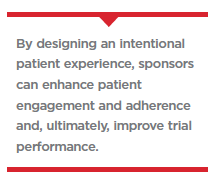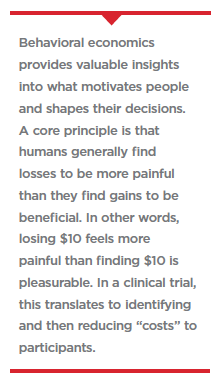The principles of behavioral science can be used to keep participants engaged, adherent to the protocol, and proud of the contributions to curing disease.
 Consumer industries have invested millions in improving “customer experience" — how consumers feel or perceive every interaction with a company. In clinical trials, the notion of “patient experience" has received comparatively less attention. That’s a missed opportunity. A patient participating in a trial has much in common with a shopper browsing in a store, ordering dinner, or upgrading mobile service. As patients or consumers, people appreciate clear communication, reliable encounters, and a chance to connect emotionally. By designing an intentional patient experience, sponsors can enhance patient engagement and adherence and, ultimately, improve trial performance.
Consumer industries have invested millions in improving “customer experience" — how consumers feel or perceive every interaction with a company. In clinical trials, the notion of “patient experience" has received comparatively less attention. That’s a missed opportunity. A patient participating in a trial has much in common with a shopper browsing in a store, ordering dinner, or upgrading mobile service. As patients or consumers, people appreciate clear communication, reliable encounters, and a chance to connect emotionally. By designing an intentional patient experience, sponsors can enhance patient engagement and adherence and, ultimately, improve trial performance.
The Building Blocks of Patient Experience
 There is no standard definition of “patient experience" for clinical trials. Leveraging decades of research in the field of behavioral economics, an approach to economics that accounts for the human cognitive, social, and emotional characteristics that shape people’s decisions and actions, Datacubed Health has identified five experience elements that determine the caliber of patient experience in clinical trials.
There is no standard definition of “patient experience" for clinical trials. Leveraging decades of research in the field of behavioral economics, an approach to economics that accounts for the human cognitive, social, and emotional characteristics that shape people’s decisions and actions, Datacubed Health has identified five experience elements that determine the caliber of patient experience in clinical trials.
1. Participant Understanding
Do patients understand consent?
Was reviewing and completing consent documentation simple and easy?
During the trial, do patients understand progress to date?
When the trial ends, do patients know and understand study accomplishments?
2. Participant Burden
What does the study require of patients?
How burdensome are all the processes — from consent to clinical visits and medication adherence to day-to-day data collection?
3. Participant Communication
What channels are available for patients to communicate with the team running the trial?
4. Participant Engagement
How are patients encouraged to be active participants in the trial?
What incentives are used throughout the study to keep patients engaged?
5. Participant Acknowledgement
How are patients thanked throughout the trial (not just at the conclusion of the study)?
Seven Secrets from Behavioral Economics
Behavioral economics provides valuable insights into what motivates people and shapes their decisions. A core principle is that humans generally find losses to be more painful than they find gains to be  beneficial. In other words, losing $10 feels more painful than finding $10 is pleasurable. In a clinical trial, this translates to identifying and then reducing “costs" to participants.
beneficial. In other words, losing $10 feels more painful than finding $10 is pleasurable. In a clinical trial, this translates to identifying and then reducing “costs" to participants.
Recognizing that friction and frustration are the enemies of patient experience, sponsors and CROs must find ways to avoid losses.
Secret #1: Avoid lost time. Work to minimize how much time patients must spend as a trial participant and set accurate expectations about how long required activities will take. For example, if a patient arrives for a visit expecting it to last 30 minutes, the encounter will be a painful loss if it ends up requiring two hours. Similarly, patients should not have to spend excessive time to complete instruments, enter data, or fill out paperwork to be reimbursed for out-of-pocket costs they’ve incurred due to the trial.
Secret #2: Avoid lost money. Strive to ensure patients do not have to miss work — and therefore lose wages — due to participation in the study. Losing income — as well as not being promptly and fully reimbursed for meal and transportation costs — has a negative impact on patient experience.
Secret #3: Avoid loss of trust. Maintain trust by ensuring that patients understand the study and what’s expected of them, that appointments are conducted promptly and as expected, and that instruments are well-designed. Patients also need to be able to provide feedback and feel heard.
Another core principle of behavioral economics is to make participation beneficial.
Secret #4: Build participant identity. Strive to make participation in the trial part of a patient’s personal identity. For example, “I’m an oncology hero, and I’m helping cure cancer." As an intrinsic motivator, participant identity makes it hard to leave a study. One tactic to nurture this personal connection is to enable patients to create a personal avatar within the trial’s mobile app.
Secret #5: Create motivational cycles. Complement the intrinsic motivation of identity with extrinsic motivational cycles. Aim to establish motivation at three scales. One, provide immediate rewards for every instrument or blood draw completed. Two, set mid-term goals — and deliver rewards — for key landmarks during the trial. And, three make trial completion the final goal and reward patients who finish it.
Secret #6: Embed meaningful goals. Make it easy for patients to track their progress against immediate, mid-term, and final trial goals. Frequent, small goals are critical, as seeing progress against them builds motivation. Consider giving patients “gems," or another digital reward, when they complete a milestone. Make it possible to exchange in-study “currency" for a contribution to a disease-related charity — an approach that powerfully combines personal identity, motivational cycles, and meaningful goals.
Secret #7: Make participation fun. When a child receives a lollipop at the end of a medical appointment, it’s a positive surprise. Find ways to incorporate positive surprises, inspire curiosity, and create amusement in the patient experience. For example, including a Wisconsin Card Sorting Test into a trial’s mobile app can transform a required task from friction to fun.
Infusing Behavioral Science Principles
One of the most powerful tools is already in the palms of patients’ hands: their smartphone. When a trial is designed around “Bring Your Own Device," the sponsor gains a valuable resource for reducing losses and making participation beneficial.
Smartphones are ideal for supporting:
Information sharing (study updates and educational content)
Data collection (ePRO, dosing diaries, and more)
Communication (reminders and notifications)
Engagement and encouragement (patient journeys and incentives)
Compensation (digital payments and charitable donations)
The smartphone also enables telemedicine visits — another powerful lever for reducing friction and loss. Not having to travel to sites, find parking, and wait in a lobby to complete an encounter reduces time, effort, and cost for patients.
Ready for Patient Experience Breakthroughs?
Choose the right strategies and tools for each study. Get patient feedback early in the study planning phase. Any solution should directly address a clear patient need. Also consider the specifics of the study design, including disease, demographics, study assessments, and study visit schedule.
Implement the strategies and tools. Allocate dedicated study budget for patient experience. Collaborate with the patient advocacy/patient experience line function in the organization — if one exists — and outsource to a vendor that can fully manage the study’s patient experience tools.
Measure success and return on investment. Obtain direct patient feedback via self-reported satisfaction, usability of the tools, and net promoter score. Compare study metrics against historical data from other similar studies.
Finally, a positive patient experience has also been shown to improve recruitment. In a meta-analysis of 45 randomized controlled trials, the following recruitment interventions were found to increase enrollment rate:
Delivery of trial information via video and text
Telephone reminders
SMS messages
Positive patient experience also helps data completeness. A National Research Council report suggests that incorporating positive patient experience into clinical trial design and conduct are critical preventative steps in minimizing the amount of missing data.
References:
Khaleel SL. Rare disease patient recruitment and retention. Retrieved from: https://www.clinicalleader.com/doc/rare-disease-patient-recruitment-and-retention-0001.
Little RJ, D’Agostino R, Cohen ML, Dickersin K, Emerson SS, Farrar JT, et al. The prevention and treatment of missing data in clinical trials. N Engl J Med. 2012;367:1355-1360.
National Research Council. 2010. The prevention and treatment of missing data in clinical trials. Panel on Handling Missing Data in Clinical Trials. Committee on National Statistics, Division of Behavioral and Social Sciences and Education. Washington, DC: The National Academies Press
Datacubed Health is a pioneering technology company making better science and healthier communities a reality. Datacubed applies individualized solutions for the capture of active and passive data for engagement with patients in decentralized trials. Focusing on healthcare and life sciences, they offer software and services driven by behavioral science to improve patient retention and compliance, resulting in better data and positive health outcomes.
For more information, visit datacubed.com


















